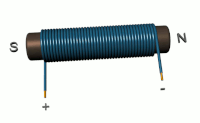
Photo from wikipedia
Magnetic levitation systems are influenced by an intense demand to gain greater feature sizes of metal nanoparticles and to increase the production efficiency for the flow-levitation (FL) method. This paper… Click to show full abstract
Magnetic levitation systems are influenced by an intense demand to gain greater feature sizes of metal nanoparticles and to increase the production efficiency for the flow-levitation (FL) method. This paper presents a systematic stability and temperature analysis of the process during the induction heating based on ANSYS. The comprehensive model was a liquid aluminum droplet levitated electromagnetically in an axisymmetric magnetic field induced by different sets of coaxial circular coils. First, we developed an optimized coil with a double helix structure to compare the force applied to the sample, electric field distribution, and temperature distribution in the eddy current field with an initial coil structure. The optimized coil has a more stable and efficient induction heating process for the FL method. We also utilized the optimized coil geometry to predict the maximum parameters of the electromagnetic induction system used to fabricate Al nanoparticles. The results from this approach shows that the turns = 2 + 3, D = 24 mm, I = ∼350 A, d = 1∼2 mm, with an equilibrium coefficient k of 0.30, are the maximum and optimal settings in the frequency of 400 kHz induction heating process.
Journal Title: IEEE Transactions on Nanotechnology
Year Published: 2017
Link to full text (if available)
Share on Social Media: Sign Up to like & get
recommendations!